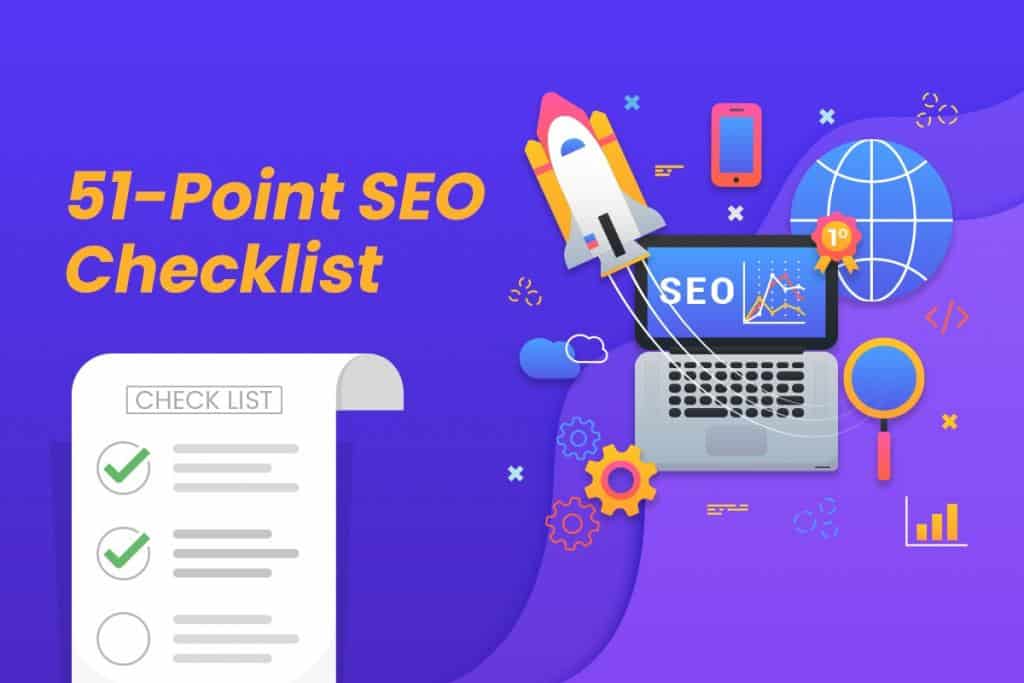
Suffering from low traffic? Developed an outstanding site but not receiving the expected return on investment? Don’t have any idea what’s going wrong? Let us help you – there may be a glitch in your SEO Checklist!
We hope you already have an idea of how powerful SEO is! This article is for those who are already running an SEO campaign but not generating good returns and those who are about to step into the world of Search Engine Optimization and willing to know how to do SEO and rank higher on Google.
We have prepared an extensive To-Do list for SEO. Keep this SEO checklist in mind while optimizing your website for search engine ranking. So, let’s explore.
How to Use the SEO Checklist
This checklist is an overview of what you need to do in order to improve your SEO strategy and ranking. You don’t need to incorporate each of the points we are going to mention, but we’d recommend implementing as many as possible.
Essential SEO Strategies You Need to Avail to Increase Leads
The points described in this list are handpicked and collected from real-time experiments. We have been able to secure our spot among the top two results on Google by maintaining this checklist. If you don’t believe, search for “web design company in Kolkata” or “web development company in Kolkata,” you will see Intlum coming at the top.
So, let’s move ahead to the main segment without further words.
Basic SEO Checklist
There are some basic SEO practices you need to implement prior to getting into the mainstream SEO. They are not going to impact your ranking directly but are a great help for backing the other factors which would have the direct impact.
1. Install Yoast (for WordPress sites) or Any Other SEO Plugin
Yoast is a true revolution in the SEO field. If you are a WordPress user, Yoast will watch your back for almost every technical job you need to perform. Optimizing your WordPress site becomes child’s play when you have Yoast plugin onboard. Some features and benefits of the popular SEO plugin are given below.
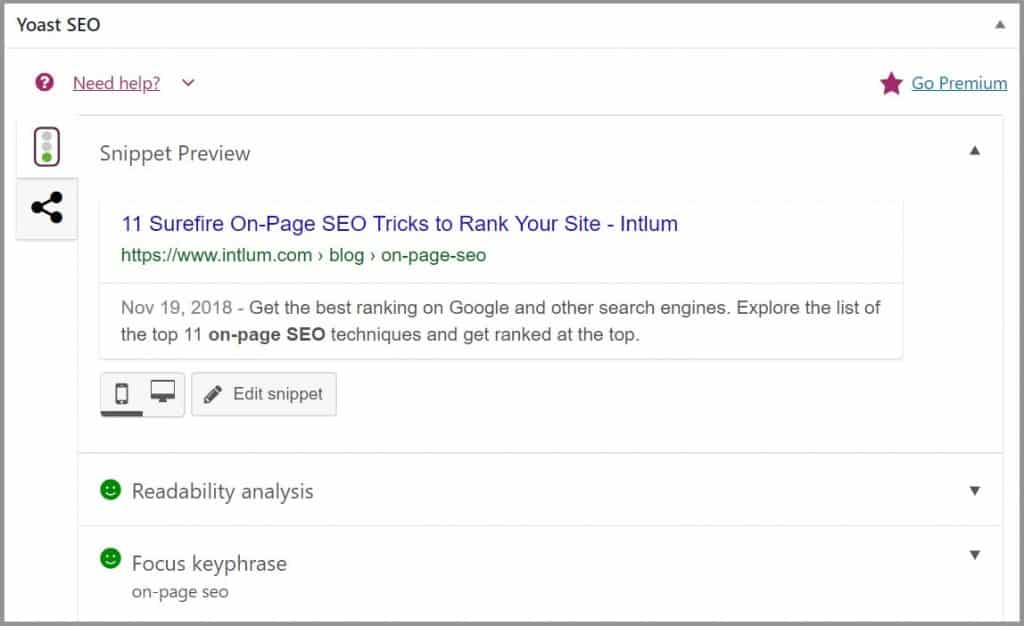
- Creates sitemap
- Creates robots.txt
- Google Analytics script installation
- Google Webmaster site verification
- Meta title and description embedding options with length prominence
- Keyword Density analysis
- Article Readability analysis
Yoast also supports some CMSs other than WordPress. You can check those CMSs supported by Yoast here. However, if you are also looking for an SEO plugin particularly for your CMS, go to Google and search – “Best SEO plugin for Example CMS.”
Install Yoast Plugin on Your WordPress Site.
Alternative Plugins to Yoast: The SEO Framework, All in One SEO Pack.
2. Install and Setup Google Search Console/Webmaster Tool
Google Search Console is one of the robust tools available in the market. This free SEO tool helps you analyze and track your website’s performance over time along with the keywords your site ranks for. Following are the features and benefits associated with GSC.
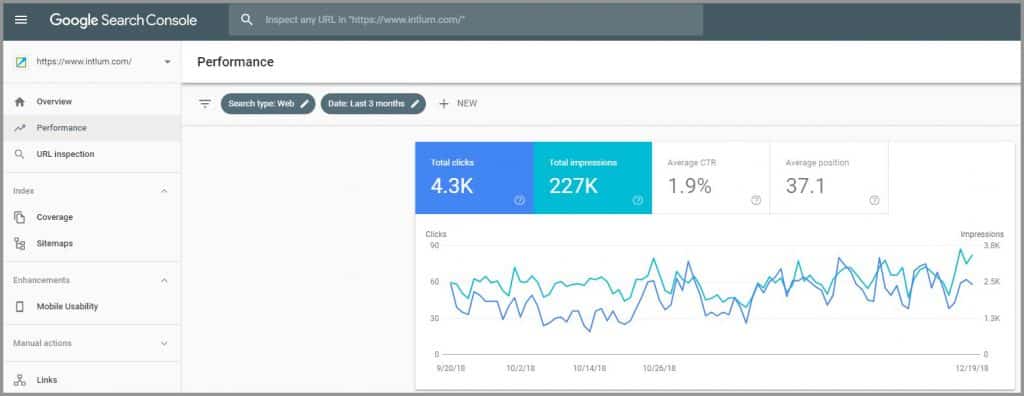
- Sitemap Submission
- Tracking the keywords that are ranking and bringing traffic
- Fixing website errors
- Website URL submission to Google for indexing
- Removing an indexed URL
- Google Disavow (Suggesting Google not to consider submitted backlinks to prevent link spamming penalty from Google)
Google Search Console is a must-have if you want an effective ranking. Track down your rights and wrongs and work accordingly – that’s the mantra.
Note: Google Search Console is the revised name of Google Webmaster Tool. So, when you read Webmaster, we are actually talking about the Search Console.
3. Install and Setup Google Analytics
Google Analytics is an unignorable tool to show you the report for the website traffic. The tool will show you how people visit your website and how they interact with it.
In order to install Google Analytics on your website, create an account on Google Analytics and collect the tracking code generated by the tool. Now, paste the code on your website to start tracking your website performance.
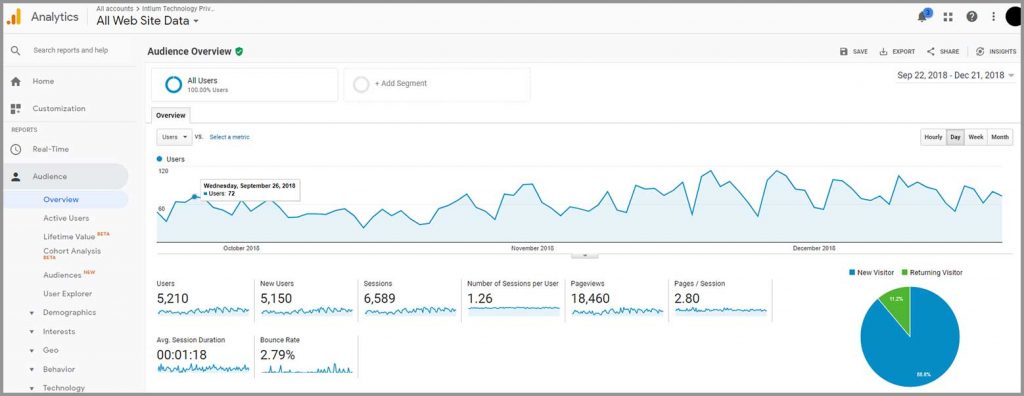
Below are a few features and benefits you will enjoy while using Google Analytics.
- Showing the number of traffic coming on your site
- Showing pages with the highest traffic
- Showing how much your traffic is increasing
- Recognizing the other search engines and sites that send traffic to your website.
- Average bounce rate, page views, and other metrics of your website.
If you want the best result, connect Google Analytics and Google Search Console. The connection between these two accounts will display further helpful SEO information inside your Google Analytics account.
4. Install and Setup Bing Webmaster
If you want more precise data, you can take help from Bing’s equivalent to Google Search Console – Bing Webmaster Tool. Despite having less popularity than Google, Bing enjoys one-third of all the searches done online. So, availing Bing Webmaster tool will help you get your hands on the one-third searchers.
Bing is the default search engine of Microsoft Edge and Internet Explorer browsers. So, when you get hold of all the users of these two browsers, your website traffic goes higher! Plus, you are going to get various features on Bing Webmaster like the built-in keyword research tool which adds to the Webmaster’s credibility.
5. Create a Sitemap
A sitemap directs search engine to the web pages where the search engine can find the vital contents of any website. Once the contents are found, those can be crawled and indexed.
If you have already created a sitemap and want to see if it’s crafted perfectly, visit examplesite.com/sitemap.xml.
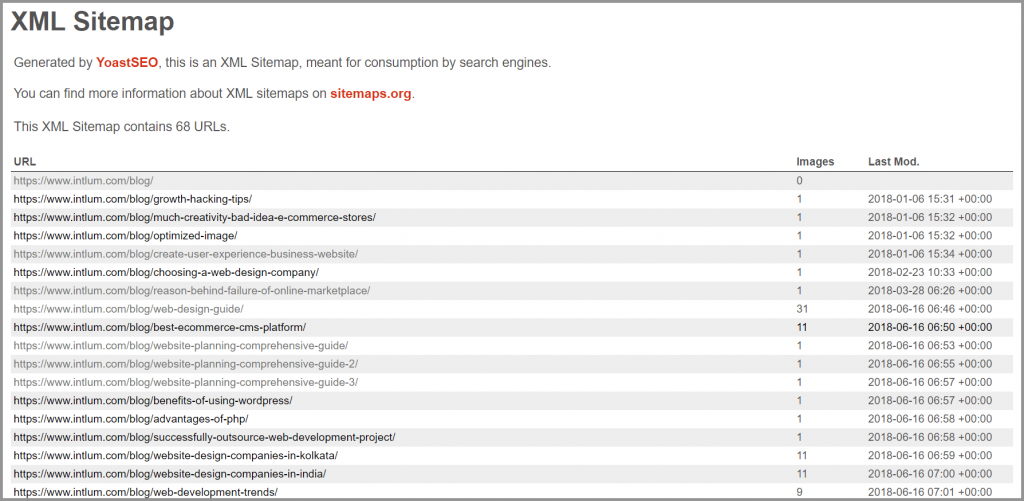
Now, you may want to know how to create one! Well, if you have Yoast SEO Plugin, it’s easy to do. Otherwise, choose one from the gamut of sitemap generators available online.
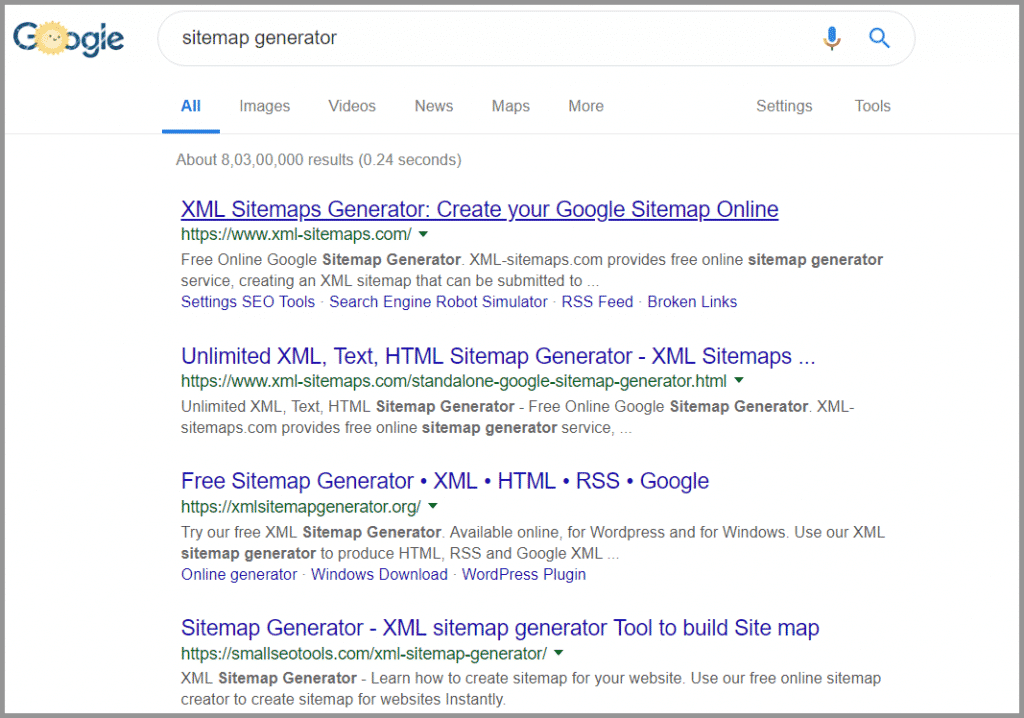
6. Setup and Integrate a robots.txt File
Robots.txt can restrict search engines to crawl certain pages on your website. This is a plain text file that allows and disallows Google’s and other search engine’s activities by telling them where to go and where not. A robots.txt file will look like below.
As you can see on the above image, the particular robots.txt file has a link to the sitemap for conveying to the search engine where to find the pages of a website followed by some commands directing the search engine not to crawl or index the web pages within the website that include “/wp-admin/” in their URLs.

Using the Yoast SEO plugin, you can easily create a robots.txt file if you have a WordPress site. Otherwise, you can avail some intuitive robots.txt file generators like this one for the non-WordPress sites.
If you aren’t sure whether or not your website already has a robots.txt file, you can check it by visiting examplesite.com/robots.txt.
Learn More about Robots.txt here.
Technical SEO Checklist
Three kinds of people are found when it comes to technical SEO:
- People who think technical SEO is surrounded by frightening codes so they don’t even try to fix the errors.
- People who don’t even know that there’s something called Technical SEO! Yes, really.
- People who have the idea of technical SEO and fix the technical errors found on a site.
We’d recommend you to be the third kind of people because a little dilemma in technical SEO can cause your site devastation in form of lowest rankings! Believe us, the technical SEO is not as daunting or complex as you think. A little attention can fix all the errors and your site can rank at the top.
We have seen sites getting drowned only because of the poor technical SEO practice though they had the other factors right like content, on-page, and off-page.
Go through our checklist to fix the technical SEO errors in the easiest way possible.
1. Detect Craw Errors and Fix
If there’s a crawl error in your website, you will never rank because Google will have trouble in viewing your content. Crawling means viewing in Search Engine language.
And it’s so simple – if Google is unable to even find your content, how do you expect it to rank you?
For finding the crawl errors of your website, visit:
- Google Search Console > Coverage (For Newer Version)
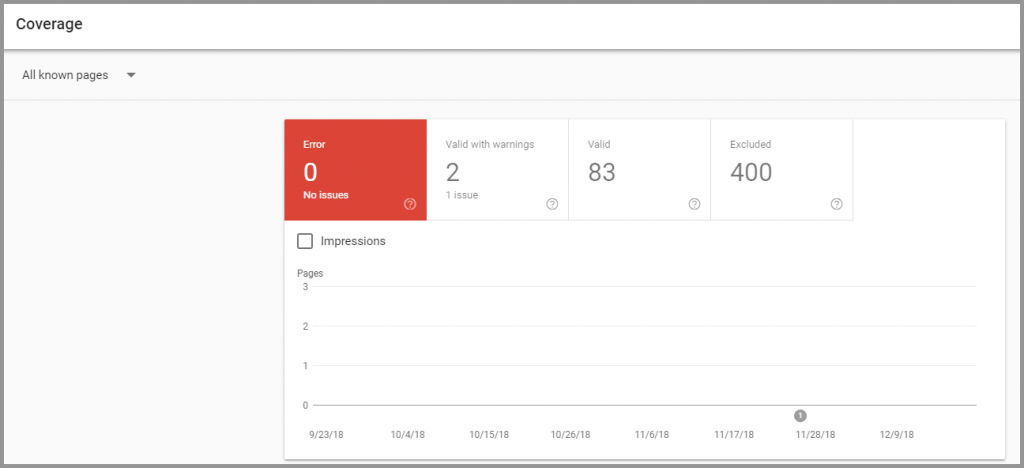
- Google Search Console > Crawl > Crawl Stats (For Older Version)
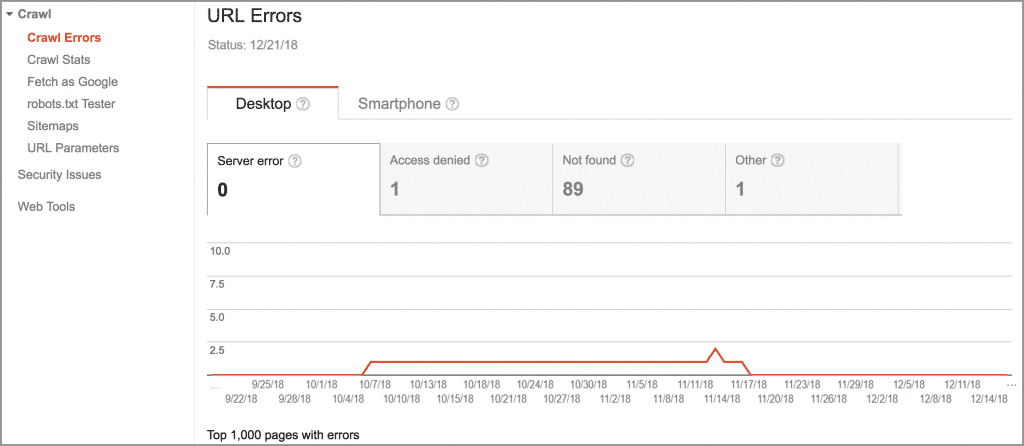
There’s another viable way of fixing the crawl errors (if web pages or images are blocked by robots.txt) – Ahrefs Site Audit.
2. Fix Broken Links
Broken links are very commonly found in websites. And they’re also commonly found among the reasons for poor ranking. You may not have a little hint but the broken links will silently kill your chances of ranking.
When the users click on a broken link, they land on a page showing 404 error! This takes the user experience upside down since users don’t reach where they intend to and they may leave your site instantaneously!
And you don’t need to be reminded how much user experience means to Google. So, you need to identify the broken links and fix them as soon as possible!
DrLinkCheck.com is the perfect platform to check your broken links.
3. Make Your Site Mobile-Friendly
With the benefits mobiles come with, the usage and popularity of mobile devices are in peak! That’s the same reason why the majority of internet surfing and searches are done from the mobiles.
And the growing popularity of mobiles induced Google to put the focus on the mobiles and make it a significant factor for ranking. And you all know the result – Mobile First Index!
The mobile-first index denotes if your site is not optimized for mobiles, it’s not going to rank well. Promptly, the mobile-optimization secures its place in Technical SEO checklist.
In order to test your site’s mobile-friendliness, use Google’s Mobile-Friendly Test tool.
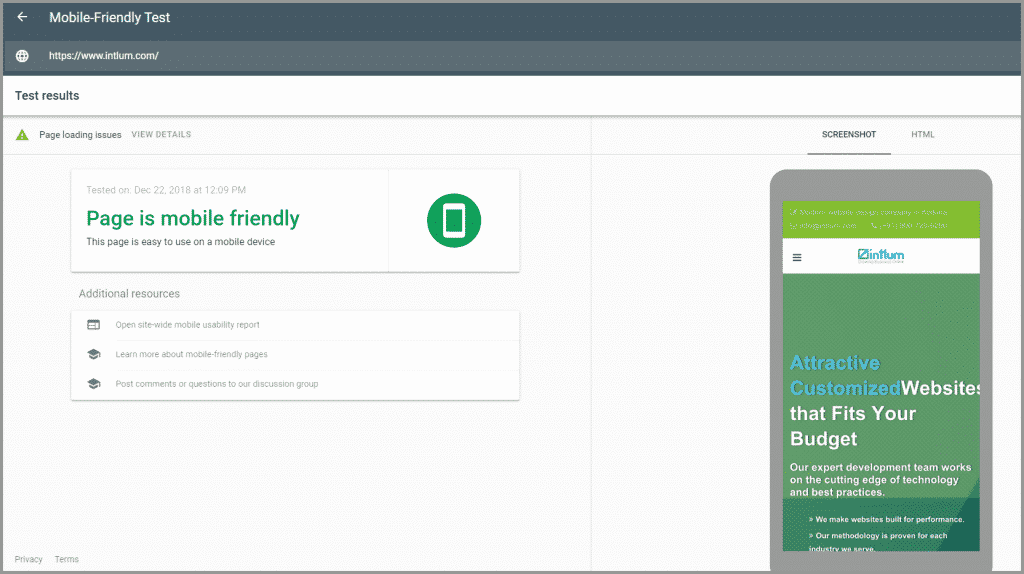
You’ll get a ‘Yes’ or ‘No.’ It’s simple. Super-simple.
4. Optimize Page Loading Time
We have kept saying, the user experience is the ultimate factor to decide your website’s fate! And your site’s page loading time is one of the prime factors of user experience.
If your site doesn’t load fast, users are not going to stick long to your site. Even they can leave your site right off the bat because it’s frustrating to wait for eternity for a page to load! If so happens, the user experience is deeply hurt! As a result, your site would never be able to climb the ladder to the top of Google SERP.
At first, check your website’s mobile speed on Google Pagespeed Insights.
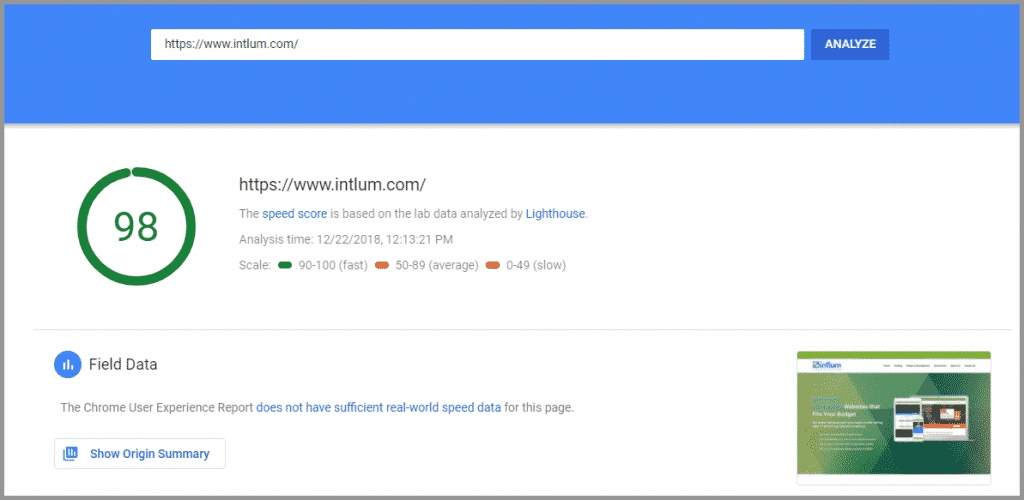
The standard page loading time should be 3 seconds at a maximum. If it’s taking longer for the page to load, check your website’s unused plugins, codes, image size, etc. to reduce the weight. the rule is simple – The lighter your site is, the faster it loads.
Read: How to Optimize Page Loading Time.
5. Fix Bad Redirects
Redirection means that you are telling the search engine that the content of a page is shifted to another page. That’s why you are redirecting the first URL to the new one.
Now, there can be two sorts of redirections – Temporary and Permanent.
The temporary redirection means the redirection is temporary and there will be a live page for the redirected URL. This temporary redirection is 302 redirection.
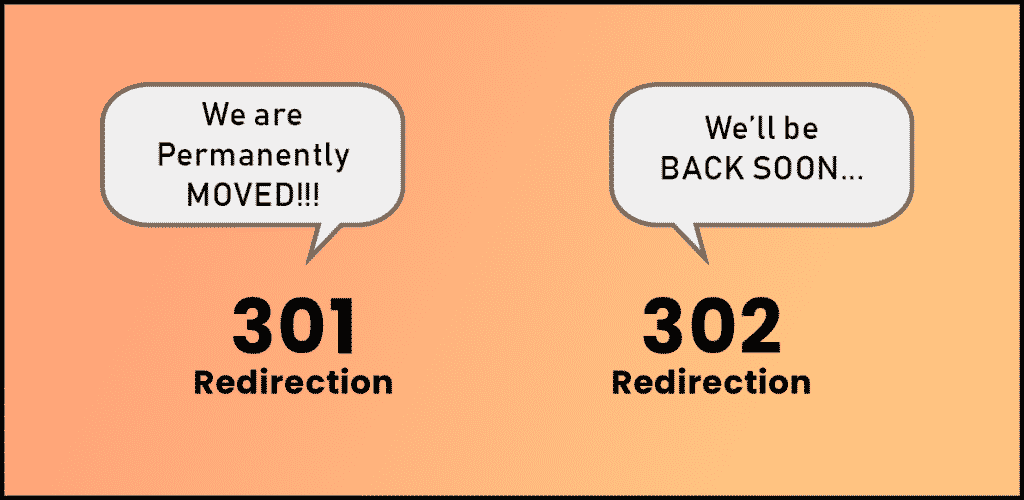
And the permanent redirection is called 301 redirections where a URL is permanently redirected to a new URL which means the first URL will never be live again.
Now, the mistake people make is they use 302 redirections instead of 301 just for the fact that they are not aware of the difference between these two!
Since the 302 redirection is time-specific and mainly for maintenance purpose, the SEO value doesn’t pass to the new destination. So, your immediate job is to replace the 302 redirects with the 301 redirects in case of permanent redirection.
6. Use HTTPS Instead of HTTP
With the increased data breaching in today’s web world, security is the foremost concern for Google. That’s the very reasons why HTTPS has become a significant ranking factor.
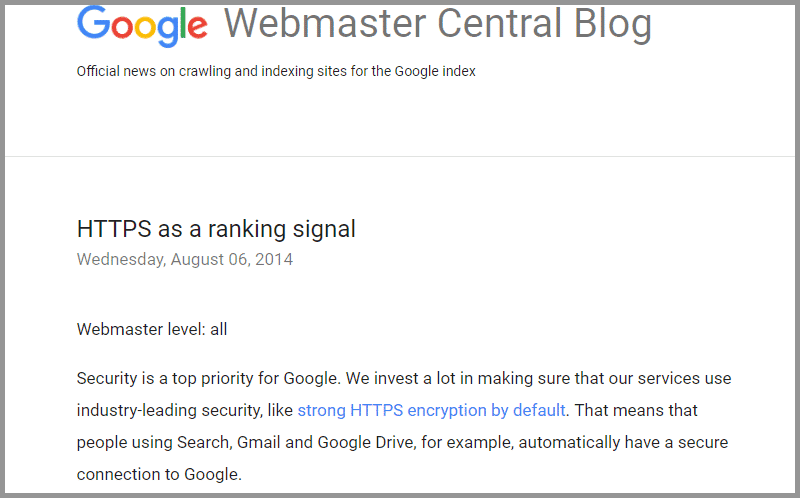
Even before 2 years, almost 80% of the top-ranking sites did not have the HTTPS as per an analysis. However, the scenario has been changing since then and more sites are switching to the HTTPS for protecting their data and ranking higher on Google!
The HTTPS is especially important to your site if you have a payment gateway integrated on your site or have contact forms. So, try to secure your site and users’ data, Google will accolade you with higher ranking as a return gift!
The ‘S’ adds to the HTTP when you avail an SSL Certificate. Contact an SSL Certificate providing company or avail a free SSL Certificate from here.
7. Fix Duplicate Content
Duplication has always been one of the major obstacles for ranking. Let us clarify, we are not talking about you copying texts from other sources. It’s about the duplication within your site. The duplicate content denotes multiple similar or identical pages on your website.
When this problem occurs, Google doesn’t understand which page to rank! As a result, none of them get ranked even if they have the potential for ranking. It’s a common issue for the eCommerce SEO since the faceted navigation may create hundreds of duplicate contents!
Identify these issues with Ahrefs Site Audit. You need to run a crawl for any site and see the magic happens. Ahrefs has really made everything comprehensible and easy for you. If you need a little assistance regarding it, you can watch this video made by Ahrefs on How to Do SEO Audit.
Alternative to Ahrefs Site Audit: SEMrush Site Audit
8. How Does Google View Your Site?
Often it happens that a user is viewing everything of your page but Google is not! One very certain aspect of ranking is that you will only get ranked when Google will have the full access to your page. Otherwise, it won’t rank.
In order to check how Google views your site or any page, use Google Search Console’s Fetch and Render option. Here’s how to do it.
- Log in to your Google Search Console account and head to “Crawl” option from the left sidebar and click on the “Fetch as Google” option from the list.
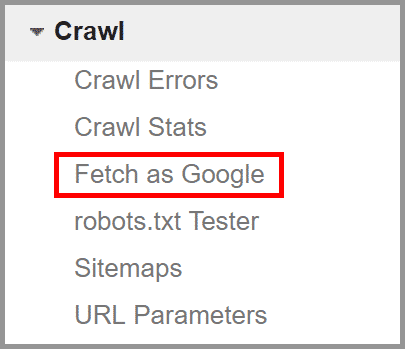
- Once you select a page, click on the “Fetch and Render” option. Then you’ll be able to see the selected page from Google’s viewpoint.
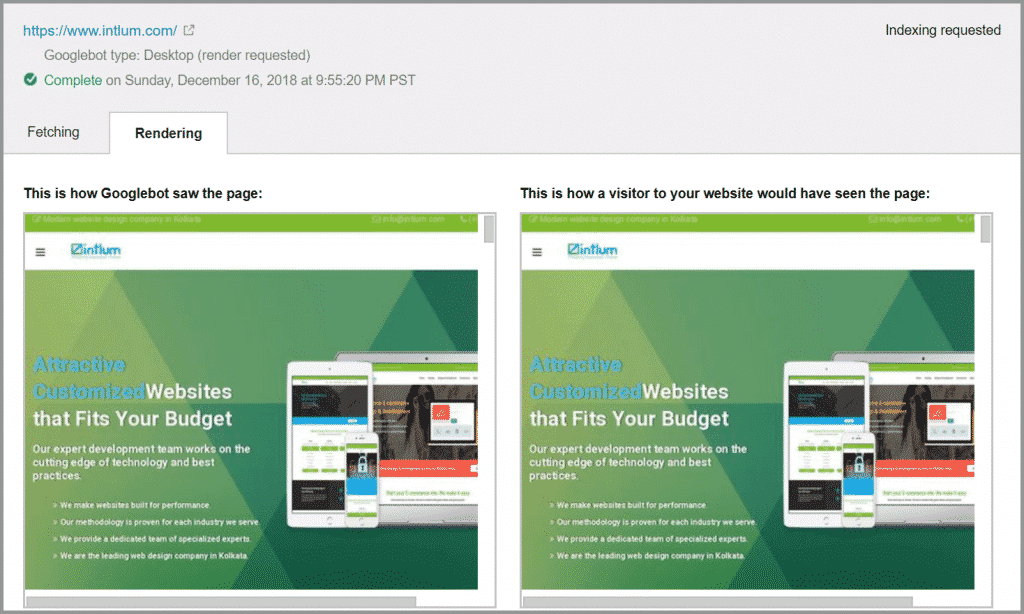
If the design doesn’t match your expectation, try to find the glitch and fix that ASAP.
Keyword Research Checklist
Keyword research is one of the cornerstones of SEO and it involves an extensive amount of effort. We have also crafted a detailed article on Keyword Research considering its immense importance for ranking. Here, in this checklist, we are going to give you some brief about do’s and don’ts of the integral part of SEO.
However, if you want to have detailed knowledge, read our detailed keyword research guide. Now, let’s get straight into the main point where you will start understanding the hacks of finding the most lucrative keywords your potential clients search for.
1. Find Focus Keyword
Focus keyword or primary keyword is the one main keyword which is the base of an article in terms of ranking. The keywords generally have higher search volume (and may have higher competition). Most of the profound blogs including Intlum target one focus keyword for their articles.
Now, the question is how to find the right primary or focus keyword! Well, in such a scenario, you may use Google Keyword Planner for extracting the right primary keyword that would bring the best number of traffic on your site or page.
2. Find Long Tail Keywords
The next stage of successful keyword research is the long tail keywords. Long tail keywords would undoubtedly be the undeniable part of any SEO checklist as they are capable of grabbing loads of audience towards your article or website without much competition.
Another benefit that advocates for long tail keywords comes from a statistic that says 15% of Google searches are unique (in terms of variations) and never searched before! So, you can already guess how much potential is left for you if you get your hands on the unexplored long tail variations.
There are various ways of finding the long tail keywords such as:
- Google Autocomplete search where you can enter a word and Google will show you the most used search phrases that can be used as long tail keywords. Just how we have entered “Keyword Research” on the Google Search and Google is showing us all the relevant search phrases related to the phrase we entered.
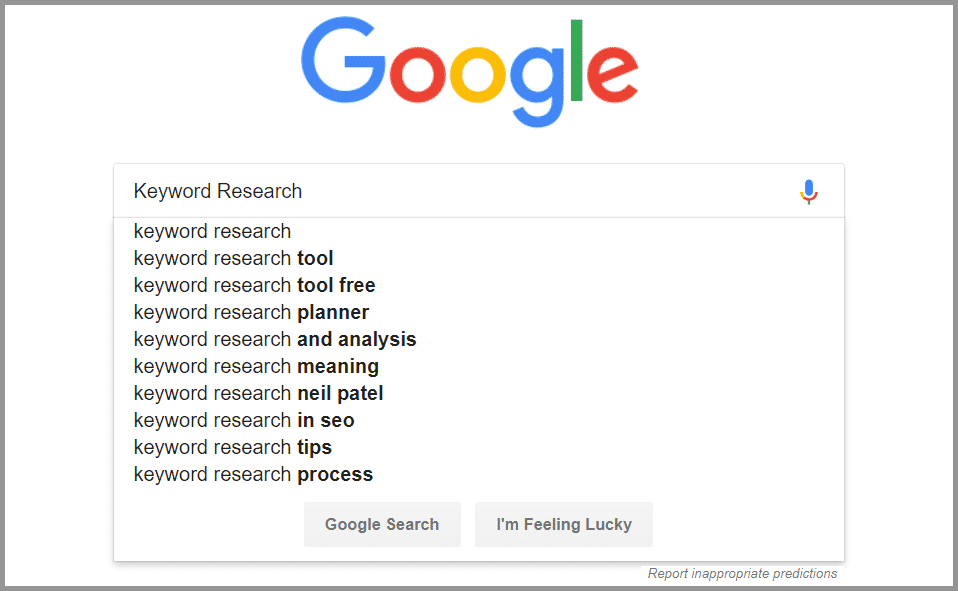
- UberSuggest, where you get all the related and long tail suggestions for any particular key phrase along with the volume.
- GKP, which is the most convenient tool to research for the long tail keywords. However, Google Keyword Planner is less considered by the modern-day SEO experts as the tool tends to generate results with the exact matched words.
- AnswerThePublic, where you will get every sort of long tail keyword including the question-based, preposition-based, comparison-based, and alphabetically.
3. Forums and Online Communities
Forums and online communities are two of the most viable sources to get your hands on the finest long tail keywords which are actually being asked and discussed by the individuals. You can visit Quora or Reddit or any other forums or communities based on your niche market and search for the primary keyword. As a result, you will be handed with loads of questions which are actually being asked and discussed.

As you can see online, when we searched on Quora for “Web Design,” we got many questions which can actually be used as the long tail keywords! Yes, they do require a little modification before transforming into a full-fledged keyword.
4. Find Real-Time Keywords
The real-time keywords are really helpful in ranking you for the keywords your potential consumers are actually searching about and want to know about! You can get these keywords directly from the Google search!
Sounds miraculous? But it’s true, damn true!
There are two ways you can discover the real-time keywords: People Also Ask box and Searches Related To section.
People Also Ask
When you perform a search, you will see a box appearing with the title – People Also Ask. Here, the related queries are registered in every possible way. Whenever you click on a particular question, a drop-down appears with the answer and the most interesting part is – two more questions get added every time you click on any question! So, it’s a mine full of questions!
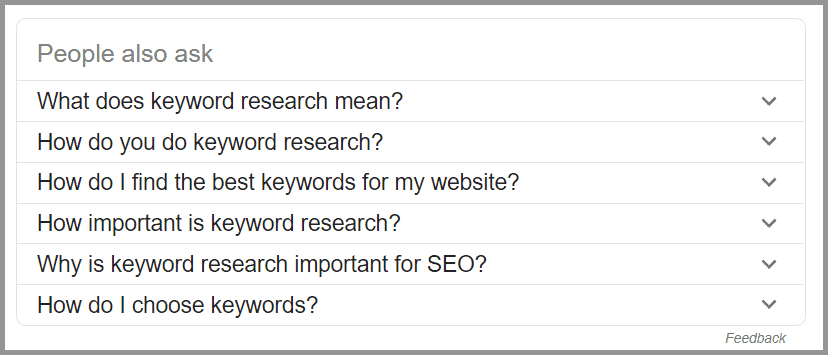
As you can see, when you searched for Keyword Research on Google, it’s showing a list of 6 questions and you can easily extract the keywords from the list such as:
- ‘how to choose keywords’
- ‘how to do keyword research’
- ‘importance of keyword research’
Searches Related To
The searches related to section also shows you the searches made by an enormous number of individuals related to the keyword you’ve put!
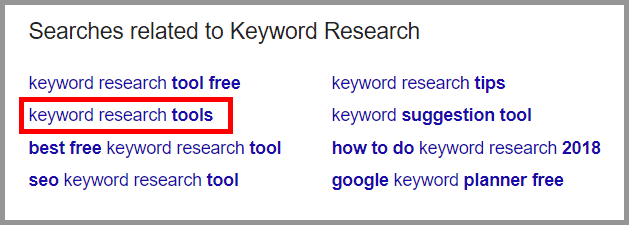
Just like the image portrays, “Keyword Research Tool” can come up as a really great keyword related to your primary keyword – keyword research.
5. Discover the Search Intent
Google has gone smarter than ever – it’s time for you to acknowledge that. Now, when you search with an obscure word which may have many different search results, Google shows the results as per the search intent. In other words, Google quickly grasps what intention the searchers may have while searching for the keyword.
Suppose, when you search for Nikon D5 on Google, the search engine will come up with the purchase links and specifications as the search results instead of articles that refers how to shoot with the camera or something like that.
This happens because Google understands that 99% of the searchers searching for the camera would be inclined to buy the camera. So, chances of ranking an article with the keyword will be very less.
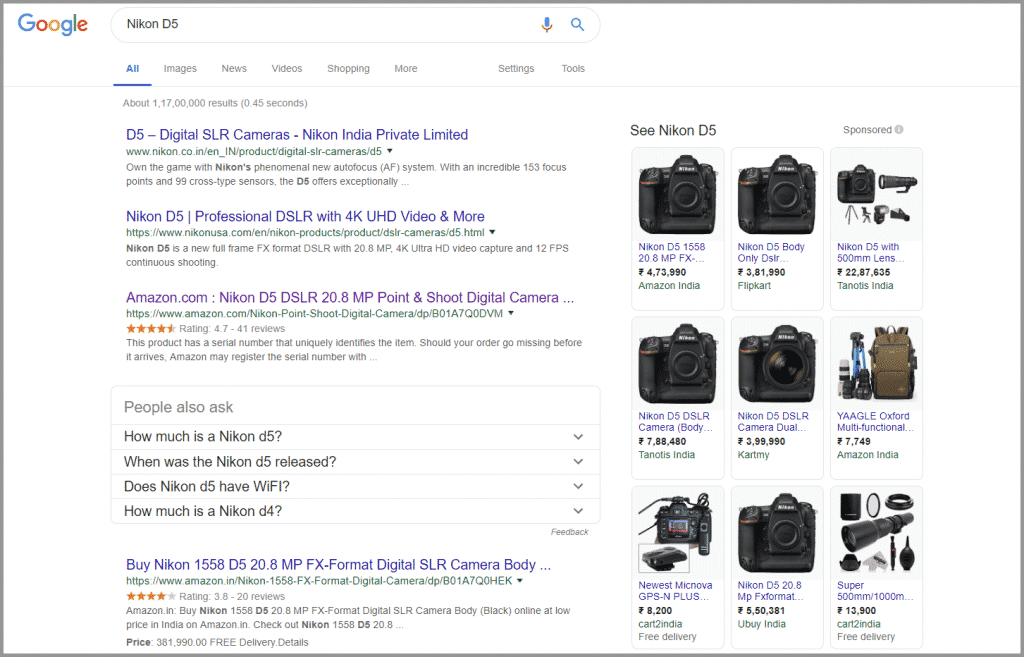
Vice versa can also happen where an article-intended keyword will be nearly impossible for you to rank through an eCommerce website.
6. Consider Competition/Difficulty along with Search Volume
The keyword competition is an important metric to consider when you are doing keyword research. A lucrative keyword would not only be high in volume but will be low in the competition! If the competition isn’t low, you should nearly give up your dream to rank!
When the competition or keyword difficulty is higher, you have loads of counterparts to conquer and some of them may even be the strongest competitors to crack!
You can check the keyword difficulty either on Ahrefs Keywords Explorer tool.
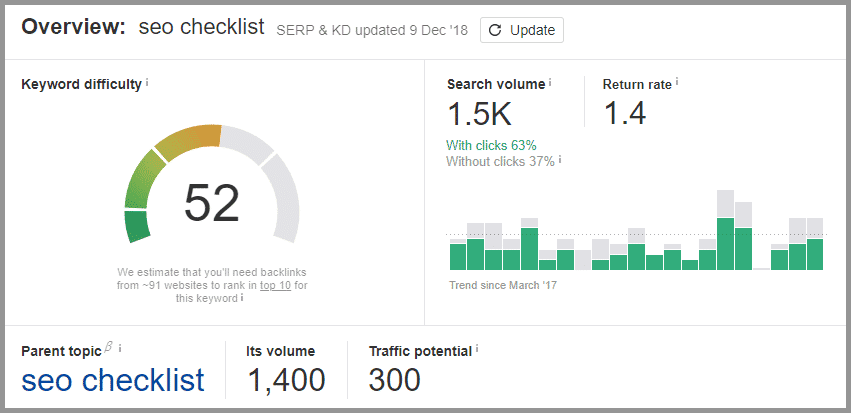
Or on Google Keyword Planner.
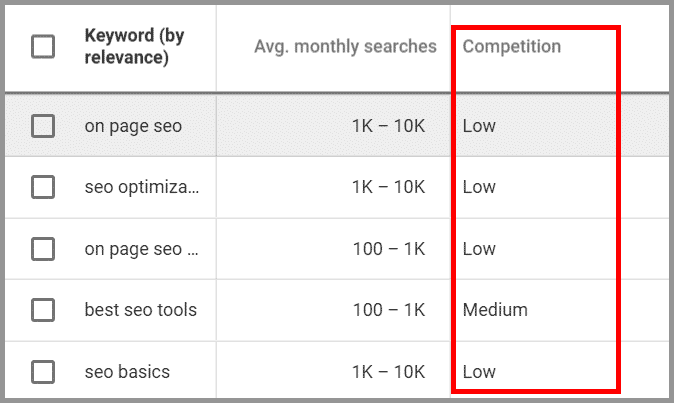
So, whenever you opt for keyword research, keep the keyword competition or difficulty in mind. However, you need to manually inspect the SERP regarding whether or not the ranking pages have good authority in terms of PA and DA.
Now, you can find the keywords with the low competition with KWFinder. Here, you can get awesome keyword suggestions with multiple metrics like Trend, Search Volume, Keyword Difficulty, CPC, and PPC. So, you can see the KD (Keyword Difficulty) and choose the low-competition keywords.
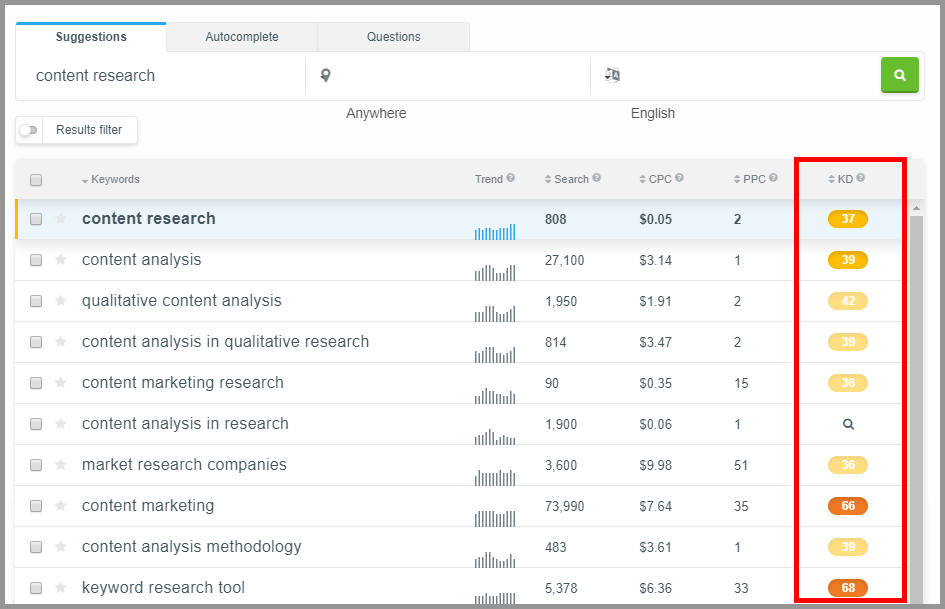
7. Use GKP and Unveil the Best Keywords
Nothing can be better than Google Keyword Planner! Yes, the authentication provided by the Google product is unmatched. Though the GKP data often seem to be less diverse and unique, you can always get the best result if you have already selected some keywords from before and want to run research for the data of the particular keywords.

GKP is a Google product itself and you can guess how authentic it will be coming straight from Google. So, make sure you are using GKP for double-checking or finding keyword ideas (if you want to do so).
On-Page SEO Checklist
On-page SEO is the fundament for ranking of any website. The on-page SEO can make or break your ranking single-handedly. Once your keyword research is done, it’s time to have a look at the on-page SEO checklist.
Note: We have also prepared a detailed article on the On-Page SEO Strategies. Please have a look.
1. Create Engaging Title Tag and Description with Keyword
The title and description tags are the elements that induce a user to click on the search result! So, you must have understood that your page’s meta title and description should necessarily be compelling. They should outsmart all the other results coming on the SERP and catch the eyeballs.
Now, are those people right when they recommend keeping the target keyword on the meta title and description?
No, they are not wrong! In fact, you always need to put the keywords on the title and description to give it a boost for ranking. But you should never compromise with the comprehension and engagement of the title and description tag for keyword incorporation. See one of our ranked aritcle below in the image.

What we mean is if putting the target keyword is blemishing the engagement, it’s better not to use. In fact, you would find very fewer results on the first page with the exact same target keyword on their title and description. Google has got smarter and it understands the synonyms and LSI, so, make use of them to create your title tag and description.
In a nutshell, it’s mandatory to have a compelling title tag and a description for each of your web pages but it’s not necessary to keep the exact target keyword in them. You can make a few tweaks.
2. Create Short URLs with Keywords
Your page’s URL should be short but descriptive. It has been proven that the shorter URLs have higher chances of ranking compared to the lengthier URLs.
However, you should never sacrifice user experience for length. What we mean by user experience is the users should get an idea of a page’s subject-matter through its URL. So, you should make it descriptive as well.
In order to make your URLs descriptive, it’s best to use the focus keyword on your URL which would not only describe your URL in the best way possible but also will optimize the URL in terms of SEO. An example would make it clear.
We have an article written before that focuses on the keyword – “web design trends.” That’s why we have also kept the URL – https://www.intlum.com/blog/web-design-trends/
3. Use Keywords on Header Tags (Especially, on H1)
Header tag is a vital aspect of SEO and any SEO checklist. The use of words on header tags, thus, becomes similarly important. When you create any post or page, make sure that you’re using the header tags in the proper hierarchy.
The use of H1 should be the least. In spite of Google’s statement of using H1 tag as many times as you want, we’d still recommend using the H1 tag for a single time. While creating the H1 tag (Mostly as the title of a post), insert your target keyword there.
Though many top-ranking pages don’t contain the target keyword in their H1 tag, it’s still good to include the keyword. Incorporating the keyword on H1 tag would not only let your users understand the topic of the page but it will also strengthen your link framing! By link framing, we mean that people, when linking to your page, will feel comfortable when you have a descriptive target keyword on the H1 tag. So, your chances of receiving links get higher.
Once you have created one H1 tag, use the H2, H3…H6 maintaining the hierarchy. The number of the following tags will increase chronologically. You can mention the keywords (target keyword, Synonyms, and LSI) on the further header tags as well.
Let us clarify that the header tags would not make any huge difference in your ranking but when SEO is concerned every little aspect counts.
4. Use Keyword on the First 150 Words
When you are crafting content with a focus on a particular keyword, you should always put the keyword on the first 150 words.
Since Google pays more attention to the first 150 words of your content, using the focus keyword there would strengthen your chances to rank higher.
Moreover, the keyword placement on the first 150 words makes it easier for the users to understand the whole content.
So, you can understand its importance for both user-experience, ranking, and on our on-page SEO checklist.
5. Use Synonyms, LSI, and Long Tail Keywords
During the days of inception, it was okay to keyword stuff content but that’s before 10 years! Now, Google is smart and it will penalize you harder than ever if you keyword stuff your content.
So, how to do SEO and how to use the keyword at the present moment? The answer is simple – you have to make use of the different variations of the target keyword. By different variations we mean the Synonyms of your seed keyword, LSI keywords, and the long tail keywords.
You may not know one fact that your page can rank with a boatload of other keywords than the targeted one! Yes, that’s true. You can analyze any of your well-performing pages on Ahrefs Site Explorer, and you’ll be able to discover a new range of keywords which you have not even optimized for!
Now, if you optimize your content with those keywords which may be synonyms of your keyword or an LSI keyword or the long tail keyword. At the end of the day, you will find that you are grabbing a lot of traffic through those keywords which could have been missed if you have only stuck to the primary keyword.
You can get LSI keyword ideas without even brainstorming for it. Just visit LSIGraph.com and put your target keyword just like we did.
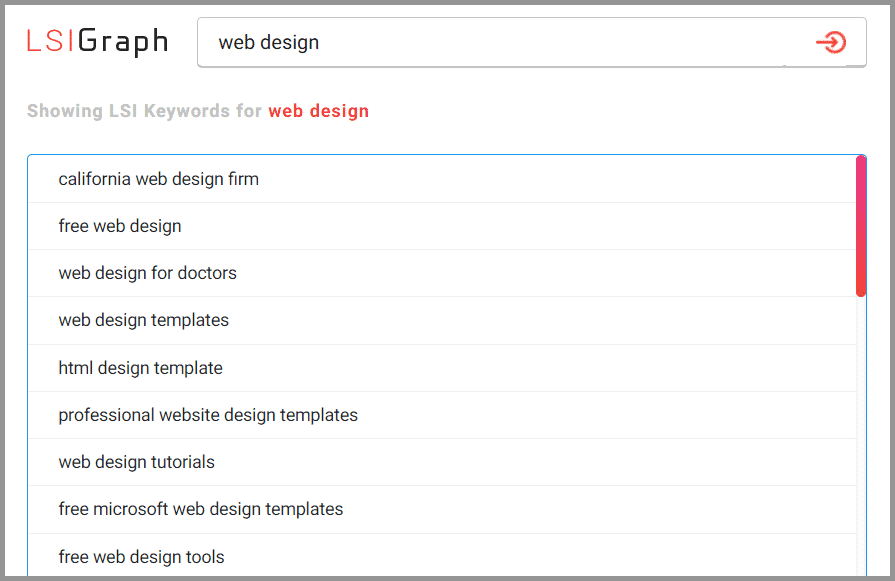
The tool will cultivate a list of LSI keywords related to your primary keyword.
6. Internal and External Linking
The internal and external link would not only help you boost your ranking but it will also help you make your post or page more reliable in front of the users. The importance of internal and external linking is undeniable and that’s why it has a secure spot in our on-page SEO checklist.
Internal Linking
Through the internal linking, you kill two birds with one stone. Internal linking not only helps you offer your users more information on certain topics. When a user finds more information on your website that they may be interested in, it will make your site more reliable to them. Also, it passes the rank juice from one page to the others.
External Linking
The external linking does the same job as internal linking but a bit indirectly! The external linking serves the information which you want to provide to the users but are missing on your site. Moreover, when you link the authoritative external sites, it builds a trust factor for your website in front of Google. Google considers that you want to offer as much information as you can to the users and want to strengthen the user experience.
However, you should always aim to link to the authoritative sites. If you need to link to a non-authoritative site, make sure that you are using a nofollow tag.
7. Optimize Images with Alt Tags
Images are the most common form of media used on any website. The images are compelling and an image can engage the users more than a thousand lines of texts. The images can hold a user as nothing can and if you think images are just for the engagement purpose and have nothing to do with search traffic, you cannot be more wrong!
Yes, it’s true. A lot of useful traffic can come to your site through the images. Image searches have taken a leap and you should take the leverage of getting hold of them by optimizing your images.
- First and foremost, make the images clear so that it attracts.
- Don’t keep the image file size too heavy so that they can collectively make your site heavy.
- Compress the image size on Photoshop or any other image size compression tool found online such as JPEGmini.
- Don’t compromise with the image quality for size. Keep a nice balance.
Now, that you have compressed your images and kept it under a considerable size, it’s time to optimize the images for SEO and Googlebot.
Googlebot isn’t a human and that’s the reason it cannot see any images neither can it be impressed with the photographic skills. Then how Googlebot understands an image? Easy; through the alt tags.
Alternative Title Tags are the texts that describe an image. Google understands texts and that’s how it reads the images rather than seeing it.
So, when you put the target keyword on the images, Google reads the keyword too and ranks your image with the particular keyword(s) when it’s searched.
Use keyword variations on the alt tags.
8. Add Schema Markup
Schema markup makes your contents more comprehensible for the search engines. Added to that, it can also affect the visibility of your web page on the SERP (Search Engine Result Page).
Schema markup, when added, can give a complete makeover to your web page on the SERP. See the difference between two different variations of the same page on SERP.
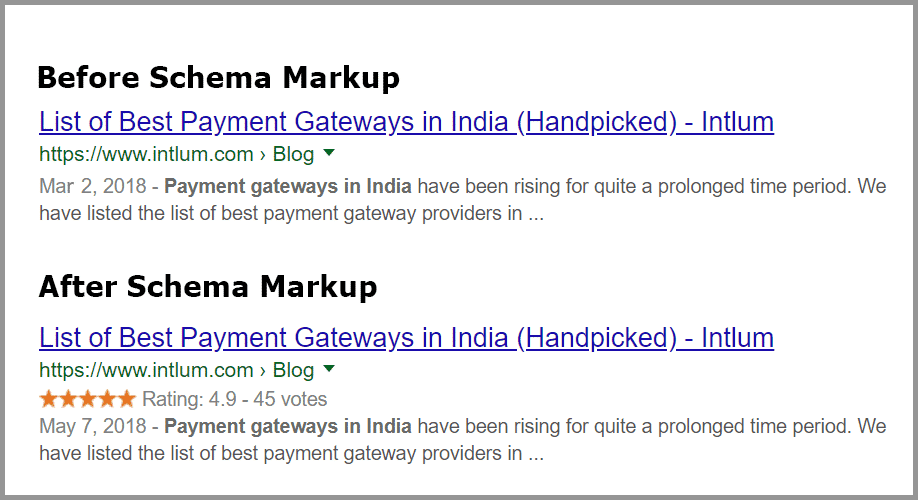
Can you find the difference between the two results of the same URL?
When the schema markup is added, it increases the CTR (Click through Rate) of a website and brings a number of eyeballs beyond your imagination.
Moreover, it’s not a hardcore technical job to implement schema markup to your web pages. Using Google’s markup helper would get the job done on your behalf.
Content Checklist
You may be tired of this maxim but we’ll again mention that Content is the King. There’s no doubt that a higher ranking on Google is only possible when you cultivate great content. Without the nourishing content by your side, you are nothing but a showpiece which would never be ranked. That’s why the content is a crucial factor to explore on every modern-day SEO checklist. Explore the checklist to discover the tricks you need to avail in order to make your content stand tall.
1. Create Killer Intro and Conclusion
An intro and conclusion should create an impression on the users’ mind that lasts long.
If you fail to convince a visitor to read your content and dig deeper into your page, you are not going to keep the user occupied for long. The outcome will come up with the user pressing the back button and leaving your site.
Let’s say, you have optimized your page really well and it’s appearing on the Google SERP among the top results. But when users are clicking on the result and starting to read your content, they get completely bored! So, what they do is press the back button and come back to the SERP. And it affects your website’s dwell time.
The only way out of this hassle is a killer intro. A compelling intro can be beneficial in more ways than one! It engages the readers, creates a trust factor among them, and most importantly, it promises to resolve a problem.
Now, what’s the need for a conclusion? Well, a user should feel interested to read your intro to keep reading. But every little piece of content serves a purpose and aims at a desired action by the users.
When you make your conclusion intriguing and it contains some actionable words smoothly arranged, the readers will be induced to take the action that you want. It can be subscribing to a newsletter (which gives you their information), making a query for your product, or anything else that you want.
So, create a drama in your intro and conclusion and make them stand out among the entire content you’ve written.
2. Use ‘Skyscraper’ Technique
If you want to publish outstanding content that stands tall, the skyscraper technique can really be a viable formula for you. In fact, many of the major blogs and organizations follow this technique to boost their website traffic.
Those who are unaware of the skyscraper technique should look at below procedure for making the most out of the technique.
- Research and find great content on the topic you are about to write.
- Read the whole content and some more available on the internet.
- Create better content than all of them.
- Now, marketize the content effectively.
Following these steps would help you nurture a more informative, well-structured, and better content overall.
3. Readability and Comprehension
Since the readers will make the ultimate call, the readability and comprehension of your content will play a big role. Readability doesn’t directly impact the SEO but it makes an impact on the users and user experience. And as you know already, user experience matters the most to Google.
So, you should pay attention to the sentence structure, use of words, and punctuations while writing something.
Make the sentence easily comprehensible, use simpler words but interestingly, don’t try to show off your stock of vocabulary because users would not appreciate referencing dictionary for every other line! And the last but not the least, the punctuations should be smartly used and should make sense.
People often take punctuations lightly and thus, make mistakes. But let us tell you that the punctuations have the ability to twist the meaning of a sentence completely! Let us give an example. That should make it clear.
- No More Black Hat SEO!
- No! More Black Hat SEO
So, as you can see, none of us want to avail black hat SEO but the second sentence is shouting to have black hat SEO just because of a subtle shift of an exclamatory sign!
4. Use Short Sentence and Paragraphs
When it comes to content, comprehension plays a pivotal role. We are discussing how to do SEO and a comprehensible content is an integral part of it. So, we should make no mistake in creating content that is immensely comprehensible and readable.
The previous point has also been related to the comprehension and this point is too!
When it comes to comprehension, make sure that you are using short sentences because the longer your sentence is, the more complex it becomes. Users would face difficulty while reading a long sentence crafted by you.
On the other hand, the long paragraphs and chunks of texts are super boring. If you still don’t realize, visit some blog on the internet and try to read an article that is comprised of the never-ending lines of paragraphs! We can bet, you’ll not feel much attracted to the article compared to the ones that have shorter paragraphs.
So, make sure you are using shorter sentences (within 20 words, considerably) and paragraphs. That way, your posts will be engaging and attract more readers.
However, don’t forget to use keywords in your paragraphs and sentences. That’s how you do SEO.
5. Create the Finest Content on the Topic with In-Depth Research
Simply put, your content would shine only when it’s in-depth and serves better information than the counterparts who were previously ranking for the keyword. But when a topic is subjective, how do you think you can cultivate the best content?
Well, the answer is E-A-T. This acronym stands for Expertise, Authoritativeness, and Trustworthiness. And these are the aspects Google looks for in any content as per the search quality evaluator guidelines.
Almost all the search results of the first page have one thing in common – they are immensely informative. So, if you want to outrank them, you should start creating the posts on a topic with in-depth research.
The more information you cater to the audience, the more you have chances to get ranked. Thus, the in-depth content is an undeniable part of our SEO checklist.
Simple, isn’t it?
6. Use Multimedia
Multimedia is something that has the power of engagement. Moreover, it has been noticed from several studies that the contents with a greater number of multimedia tend to rank higher than the contents with fewer multimedia.
This has a simple reason – when you use multimedia on your posts, it comes as a fresh breeze in the claustrophobic chunks of texts. Thus, the users love to stay on your page and read more.
Multimedia can come in many forms – image, video, audio, chart, infographics, etc. Multimedia is basically a visual or audible representation of your text content. The human mind can grasp the multimedia much better than the texts and that’s why the internet users adore those contents that have multimedia.
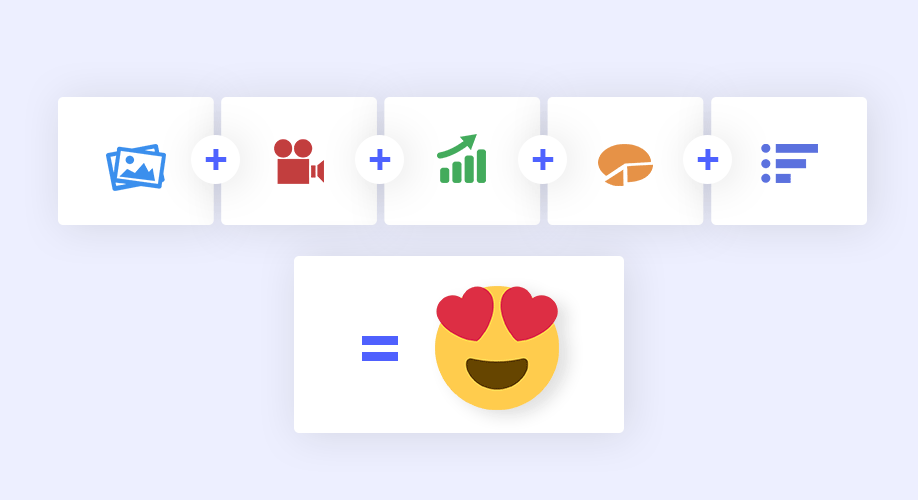
And as you’ve already guessed, the more people adore you, the more you’ll be adored by Google! Using multimedia is, therefore, a great SEO practice.
7. Optimize Content with Keywords
In the quest for engagement, you should never forget about the keywords. Remember, keywords are the building blocks of any successful high-ranked content. That’s why keyword placement in content becomes insanely important among the top SEO factors.
In 2019 and beyond, keywords will have their own share of importance whenever the SEO will be in concern.
We’ve already discussed how to put long-term keywords, synonyms of keywords, and the LSI keywords apart from the primary keyword in your content. and we’ve also mentioned how you should use the keyword in the H1 tag.
Now, the only thing that you need to know is that the keyword should be there on the first and the last paragraph of your content. Also, make use of them in the middle in the right proportion. Yoast prefers 1.5% keyword density in the content. However, you can make less use of it. It’s just the maximum limit of density.
Link Building Checklist
Link building is not easy. But link building is the key to success in SEO. You may have heard the maxim that says, “Which comes first? Content or Backlinks?” This maxim says everything regarding the importance of backlinks and link building. When something is compared to the most vital ingredient of SEO (i.e. content), it must be really important!
But building credible links is considerably the toughest part of SEO as you don’t have any control over the matter. A backlink is a link that is given to your website or a particular web page by another site considering your authority or post’s credibility.
So, if someone doesn’t want to link you, your outreach efforts get wasted. And thus, you need to be tricky. Many bloggers would not want to talk about link building strategies because it comes with a handful of difficulties.
But we are here with all the link building hacks for you because Link Building is among the top 3 factors of Google ranking signals.
1. Copy Your Competitors’ Backlinks
Today is the age of smart work. So, why should you waste time for finding authoritative sites (which may give you links and help you climb the ladder to the top of SERP) when you can just replicate the links built by your competitors.
So, the question is how to get the backlink profile of your competitors? You can avail two different ways as per your convenience. We’re going to explain both of the techniques. You need to choose the one you are comfortable with.
First Option: Ahrefs Site Explorer
Well, there are several tools available in the market. But Ahrefs Site Explorer is the best tool till now.
- You can just head over to the tool and analyze your competitors’ URLs (copied before). When searched, there will be a handful of results which will show you the Backlinks

- Now, you just need to click on the tab and you will discover the links they have received from the other sources.
- So, you can visit the same sources for links since your competitor (who’s from your domain and has managed to get links from the sites).
Second Option: Ahrefs Link Intersect
Now, you can skip all the hassle and analyze the backlink profiles of as many competitors as you want! Wait, what! Yes, it’s true. You can do it all at once through Ahrefs Link Intersect Tool.
- Here, you just need to put your competitors’ URLs on the given fields and select whether you want to check any particular page’s or the whole domain’s backlinks.
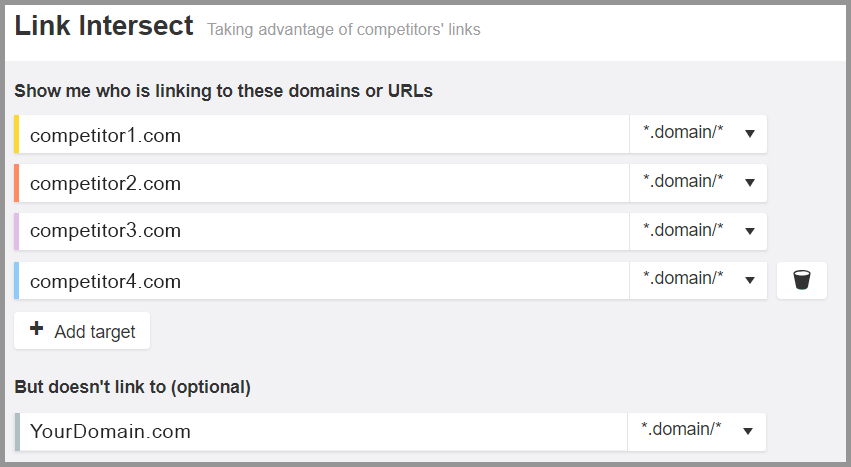
- Then you may put your website link on the “But doesn’t link to (optional)” field which will make sure that you are receiving the backlink sources of your competitors which have not linked to your site.
- So, the whole “finding with a sharp eye and wasting hours of time” thing is over.
2. Build Backlinks with Guest Posting
Guest posting has been around the SEO industry for quite a while and will always be a viable part. Guest posting is the best way to reinforce your backlink profile and that’s why it will always be a part of the SEO checklists of any kind.
But guest posting isn’t limited to the link building. Rather it goes beyond to offer you the finest exposure you may ever receive. If you are able to post articles on a popular site which good traffic potential, it’s a matter of time to get a myriad of traffic landing on your site each day.
When a site publishes your contents, you are going to receive a backlink (should be a dofollow one) if you have kept any anchor text in your content.
However, it’s highly recommended to get backlinks from the authoritative sites because the backlink profile established with links from the low-DA sites will only end up bulking up your backlink list and will have no positive impact!
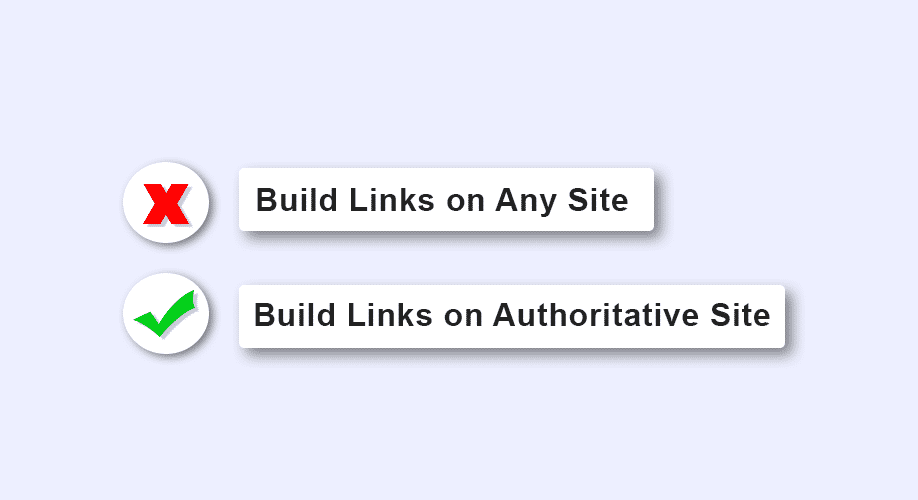
If you can successfully and regularly post contents with links on the worthy guest posting sites, a surge of traffic is our assurance.
3. Link Roundups – A Mine for Contextual Backlink Generation
Just think about a scenario where people are publishing blog posts with the sole purpose of linking out to the quality contents. Well, that’s a real thing! Most of the people don’t know about it. But yes, that’s a reality sounding like a nice sweet dream called Link Roundups!
And we are pretty sure that you are already publishing the blogs with quality content. So, what are you waiting for? Jump into it!
Link Roundups are basically the monthly, weekly or daily blog posts that give links to the finest contents relating to the context of their posts! Fascinating? Yes, it is. But how to do it? Follow our procedure.
- Find the link roundups in your niche subject with the help of the following search strings:
- Keyword + Link Roundup
- Keyword + Roundup
- Keyword + Best Of
- Keyword + This Week
- The second step is to pitch your content to the moderator or owner of the roundup. Simply put, the person should be able to make decisions regarding the acceptance or rejection of your content. You can send an email with a catchy request.
- If your content is really good, you get a backlink. Otherwise, not.
4. Reclaim Lost Links
If you think managing to create a link is the last effort you need to put, you are living in dreamland! Yes, that’s true. Links are not going to last forever. And you need to keep an eye on your precious backlink profile to discover which links are lost!
Links can be eliminated for more than one reasons and you need to discover the lost links. Once you recognize the links which have been lost, you should aim at reclaiming those links as soon as possible to keep your backlink profile strong.
However, some of the backlinks will be easier to reclaim and some of them cannot be reclaimed.
So, which links are easy to reclaim? Well, if you’re using Ahrefs, you’ll be able to see some links marked as “link removed.” These are the links you should aim at reclaiming because these are the links the author decided to remove for some given reasons!
Now, your task is to determine why the link was removed and give a viable reason to the author why the link should be reinstated.
Remember, how hard you tried to get one backlink on board? So, work harder to have them up and running. You know the worth of every single backlink for doing SEO and rank higher!
5. Find Out the Unlinked Mentions
The unlinked mentions can be a viable source to generate new backlinks for your website! For a better comprehension, unlinked mentions are the citation of your brand or any product/service of your brand without any link to it!
So, what you need to do is contact the author or owner of the blog or site where your brand or product is mentioned and ask them to link to your site. The chances of them linking to your site is pretty high because they already are aware of your brand and thus cited your brand name. If you are able to compel them properly, it’d not be very hard to get a quality link!
Now, the question is – how to find the unlinked mentions?
It has a simple technique.
- Visit the Content Explorer section of Ahrefs and put your brand name (in our case, Intlum) on the search field.

- Now, we have eliminated the results where intlum.com is linked by appending the search with -site:intlum.com.
- Now, you can add filters like sites with the English language or 30+ DR (Domain Rating/Authority) or 50+ organic visits per month or any other filters you want to include.
So, go for it.
6. Become a Podcast Guest
There’s another way of building a good number of backlinks for your website or for any particular web page – become a podcast guest! This is quite similar to the guest posting and pretty effective in bringing some backlinks home.
Rather than writing as a guest, you can contribute as a podcast guest. And in return to your contribution to the podcast, you’ll get a valuable backlink!
7. Reach to the Right People
When you have awesome contents, there’s nothing to be ashamed of in promoting the content and reaching to the important people who don’t even know that a vibrant content (like yours) exists!
Therefore, you should make a conscious effort to reach out to the right set of people. But who are the RIGHT PEOPLE?
The right people for your backlink profile would be interested in your content and will have the caliber to link you. This group of people is often termed as linkerati.
You can reach to the people through outreach emails. But make sure, you are putting effort on those emails and not sounding like spams!
Don’t just send a bulk generic email to 100 of top individuals. Take your time and add some personalization, emotion, and effort into the emails. Yes, these things reflect even if you don’t see. If these are not there in your email and it nags about linking, your email is surely going to be deleted!
8. Have the Influencers Mentioned in Your Blog Posts
Influencers in your industry are called influencers because they can influence. It’s simple. So, you should have the influencers onboard by mentioning them on your posts and informing them that you have mentioned them.
Those influencers can influence many people (read, potential consumers) to visit your brand for any concern and most importantly, they can give you links from their precious crowded social profiles!
Once you mentioned an influencer, shoot him/her an email mentioning everything you have done. And ask politely whether it’s possible for the influencer to share your post on social media or give your link on any of their own posts.
Most of the time, you’ll get a nod if you have crafted a great post. And it concludes to a higher amount of traffic and a brand-new backlink that actually matters.
SEO Checklists for Pro
Since you have gone through everything regarding the primary SEO factors, it’s time to dig deeper. In this section, we are going to mention the advanced SEO checklist which will help you rank your site easier than ever!
1. Increase the CTR by Optimizing Your Site
CTR stands for Click Through Rate which is simply the number of clicks your page receives. CTR is an incredibly important factor for ranking on Google since it depicts the interest of people on your post. Simply put, the greater number of clicks you get, the higher Google ranks your site or page.
Once you applied everything for ranking your page on the Google and you get a significant ranking, the CTR would determine whether your site’s result is going higher or lower!
CTR is simply a strong ranking signal for Google as more CTR defines the better user experience. And we’ve always mentioned how Google adores the user experience these days.
2. Build a Strong Social Presence
Despite the fact that building social presence comes under the Social Media Optimization, the social presence has an unignorable effect on the SEO and thus, it made to our list of the top SEO checklists.
Social media will indirectly but firmly have an impact on your SEO efforts. Therefore, you should always make sure that your social media profiles have your website link and your website have social media integration.
Check what your competitors are doing on the social media and share posts, boost them (if needed), interact with your followers. That’s how you create a strong social presence which pays you off with better branding, increased organic traffic and a little more boost to ranking.
3. Double-Check with SEO Audit Tools
Man makes mistakes and it’s known to all. So, there can be some mistakes in your SEO practice and let us tell you, it’s okay. But what you need to do is double-check everything that you’ve done till date. Unless you double-check everything, there’ll be a scope for a glitch; no matter how good you are!
In order to double-check your SEO activities, an SEO audit tool will be the best help! Manually double-checking all the mountain of works can be intimidating and time-consuming. Since we believe in smart work and time-efficiency, it’s recommended using an SEO audit tool which can perform hours of jobs in minutes!
Ahrefs, SEMRush, and Moz are some significant names among the SEO Audit Tools available in the market.
4. Get Over Website Downtime
Your website downtime can kill your ranking. Did you know it? Probably not!
Well, when your website is not up and running, not only the users will get disheartened but the search engine is also not going to appreciate it. Google has been very specific about the website downtime’s negative outcomes when they stated that the unplanned website downtime can negatively impact the search ranking. Read exactly what they stated.
However, there’s good news that you have a tool like Pingdom that pings your site at least a hundred times a day to see whether or not your website is up and running.
If your site is down, you’ll be notified instantly, so, you can fix the problem ASAP.
5. Clear the Clutter
For getting your website or web page ranked, you need to ensure that your site is not bulked up! Google always recommends having a light website with minimum pages possible.
And the Webmaster Trends Analyst for Google Switzerland, Gary Illyes put an end to the confusion with the following statement:
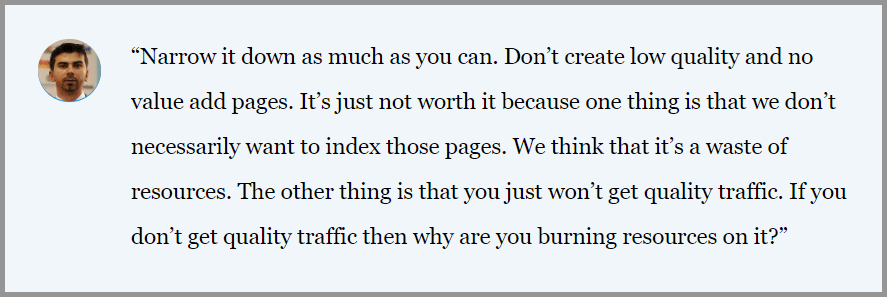
Moreover, not only reduce the number of pages but you should also aim at reducing the unused plugins, add-ons, and extensions of your website. All these can bulk up your website collectively and it will create obstacles for your ranking.
There’re some ways of getting rid of the weight of your site:
- Use a plugin that does multiple jobs. So, you can have one plugin instead of multiple.
- Eliminate the codes that are of no use.
- Compress your images.
- Focus on quality over the quantity. So, create only the quality posts that give you results.
- Eliminate outdated blog posts.
- Delete old service pages.
- Eliminate low-quality blog posts.
- Delete archive pages.
The lighter your site, Google will feel more comfortable in lifting it up.
6. Update Content
Let us tell you, you may have a whole mine of useful resources that could give you an enormous number of search traffic, would you believe us?
Well, believe us or not, that’s true if you have a blog section! There are some old blogs which might have done well (or might not) but collecting dust at the moment. They need a little polishing to do really well in terms of a higher ranking!
Yes, it also relates to the user experience. When you have outdated content, the users stop getting useful information out of those. So, what you need to do is updating the content in terms of information, structure, and formatting.
When you do so, users will be stuck to your old blog posts and you’ll start getting a lot of missing users as a result. So, update your content and republish the blog to get your hands on the search traffic you are missing!
7. Stay Sharp for Local Search
When you are doing business physically, search site citations and local directories are the only way you can get the desired exposure.
Having a local listing (done through Google My Business) ensures that you are owning and claiming your brand properly. However, you also need to make sure that your name, address, and other contact information are precise and steady over the social and local directory listing websites.
The most required element in the online world is the reliability and that’s what every online user looks for. So, when you have a consistent and precise NAP data (name, address and contact info) all over the huge local directory ecosystem, it will create a trust factor for your business among those users. So, you get more clicks and queries. Therefore, your ranking goes higher!
Conclusion
We hope you have read everything mentioned in our SEO checklist meticulously and tried to gulp everything we mentioned. Did you have any problem with comprehension?
If so, write back to us so that we can guide you. Don’t do anything without proper comprehension as SEO is a delicate job and it needs to be done with the optimum level of know-how. Otherwise, you are not going to see the upsurge!
Those who want to know how to do SEO should get their answer in this checklist. Now, go and get the place you deserve.









